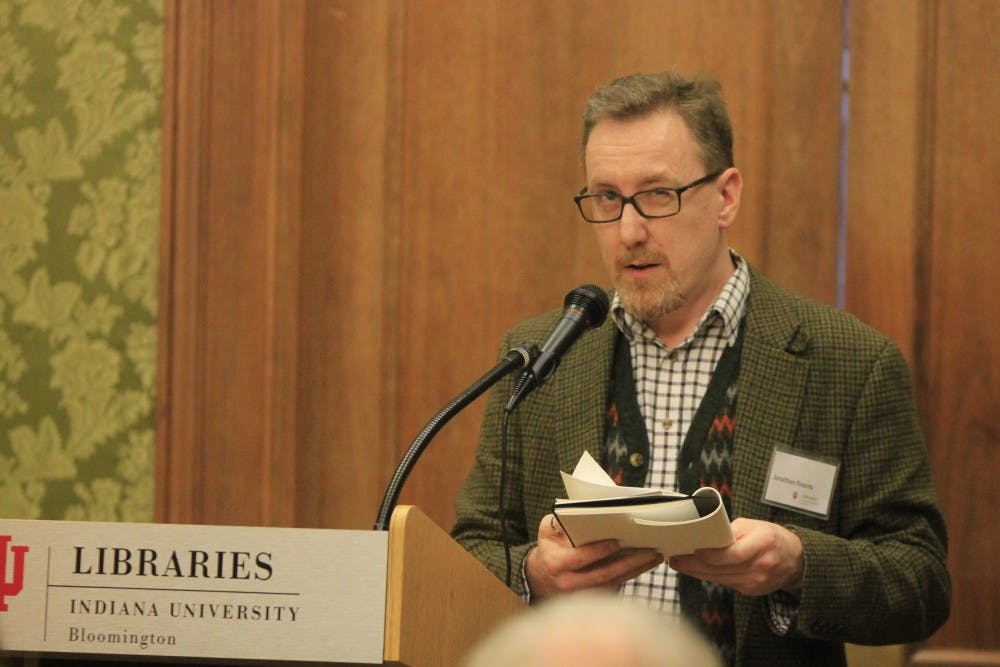In 1818, one of the most famous literary monsters was introduced in the anonymously published “Frankenstein; Or, the Modern Prometheus.” A first edition of Mary Shelley’s classic novel is now displayed in an exhibition at the Lilly Library.
“It is possibly one of the most beautiful and special books I’ve ever held,” said Rebecca Baumann, exhibit curator and Head of Public Services.
Frankenstein 200: The Birth, Life, and Resurrection of Mary’s Shelley’s Monster focuses on inspirations for the novel, adaptations and other examples of how the story evolved over 200 years. The exhibition will be open until December 2018.
Thursday’s opening lecture featured bookseller Jonathan Kearns. He is the owner of Jonathan Kearns Rare Books & Curiosities in London. In his talk, he discussed the origins of “Frankenstein” and the eccentricities of people in Shelley’s circle of friends.
Shelley originally wrote the story in 1816 while she was staying near Geneva with poet Percy Bysshe Shelley and a group of friends that included Lord Byron. “Frankenstein” was born when Byron challenged the group to write a supernatural story. Shelley then wrote her story about Victor Frankenstein and the creature he creates and then abandons.
“Mary charged on, inspired and changed history forever,” Kearns said. “She made the monster a complex, abandoned creature.”
Baumann said the “Frankenstein” novel was stitched together like the monster it describes. The exhibition includes books that influenced Shelley, including some published before “Frankenstein.” It features books by early feminist philosopher Mary Wollstonecraft and philosopher William Godwin, who were Shelley’s parents.
One case in the exhibition focuses on books mentioned in the novel, including "Paradise Lost." It displays a first edition of the epic poem. There are early editions of the “Frankenstein” on one side of the room, and comic book adaptations of the story on the other.
Baumann is a science fiction and horror enthusiast. When she realized 2018 was “Frankenstein’s" bicentennial, she saw the opportunity to create an exhibit related to those genres. This is the first Lilly exhibit centered on one novel, she said.
“I thought it would be challenging to show one book and show all the different influences,” she said.
Kearns sold the Lilly many of the books in the exhibition, including the third edition of “Frankenstein,” which was published in 1831. He also sold them books for the “Weird Women” case, which includes early science fiction and the supernatural books written by women.
It was a genre kicked off by Shelley, he said.
“It’s kind of like the history of weird fiction in the 19th century, which is when we really started to understand that these were things people wanted and needed to write about,” Kearns said. “These are dominated by women.”
Walker Byer, 28, attended the opening. He said he enjoyed looking at materials in the exhibit like Heinrich Cornelius Agrippa's “Three Books of Occult Philosophy.”
“I love the exhibit," he said. "It’s an area of interest of mine — the macabre or the occult. I love the way Rebecca has tied everything together.”
Kearns said the exhibition is a tremendous collection of books, including “weird fiction” in the footsteps of Shelley’s “Frankenstein.”
“Weird fiction is the fiction that is used for pushing back boundaries and destroying social conventions,” he said. “The writing of a book of this nature is a seditious act in of itself. It is a revolution. That’s what these books are.”




